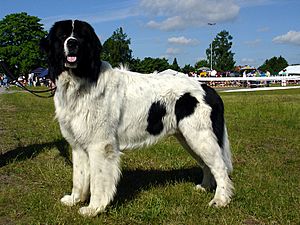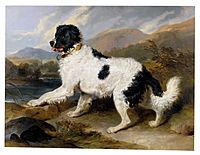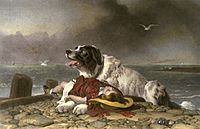Landseer dog facts for kids
 |
|||||||||||||||||||||||||
| Other names | Landseer Newfoundland | ||||||||||||||||||||||||
|---|---|---|---|---|---|---|---|---|---|---|---|---|---|---|---|---|---|---|---|---|---|---|---|---|---|
| Origin | Canada | ||||||||||||||||||||||||
| Foundation stock | Newfoundland | ||||||||||||||||||||||||
|
|||||||||||||||||||||||||
| Domestic dog (Canis lupus familiaris) | |||||||||||||||||||||||||
| Other names | European Continental Type | ||||||||||||||
|---|---|---|---|---|---|---|---|---|---|---|---|---|---|---|---|
|
|||||||||||||||
|
|||||||||||||||
| Domestic dog (Canis lupus familiaris) | |||||||||||||||
The Landseer is a large, friendly dog breed. It first came from Canada. It looks a lot like the Newfoundland dog, but it's always black and white. In many parts of continental Europe, the Landseer is seen as its own special breed.
History of the Landseer Dog
The Landseer and Newfoundland dogs both came from dogs used by fishermen. These fishermen worked in the Newfoundland and Labrador area of Canada. People think these early dogs were a mix of water dogs and livestock guardian dogs. These dogs were brought over by fishing boats from Portugal and the Basque region.
During the Victorian era (a time in the 1800s), black and white Newfoundland dogs were very popular. They were even more popular than the solid black ones. Many artists in the 1800s painted these dogs. Famous painters like Sydenham Edwards and Philip Reinagle showed them in their art. The most famous artist was Edwin Landseer. People started calling black and white Newfoundlands "Landseers" as early as 1896, named after him.
In the 1900s, solid black Newfoundland dogs became more popular. The black and white ones became less common. So, in the 1930s, some breeders worked hard to bring back the look of the dogs in Landseer's paintings. Their efforts led to the Landseer becoming its own breed.
In places like Great Britain and North America, black and white Landseer dogs are still considered a type of Newfoundland. But in 1976, a special club for Landseer dogs was started in Germany. Soon, similar clubs began in Belgium and Holland. Now, in continental Europe, the Landseer is officially a separate breed. It even has its own recognition from the Fédération Cynologique Internationale, a big international dog organization.
Landseer Genetics and Appearance
The Landseer's black and white fur comes from a special gene. This gene is called the piebald color allele. It's a recessive trait, which means both parents must carry the gene for puppies to be black and white. Because of this, a single litter of puppies can have both Landseer (black and white) and solid-colored puppies. It all depends on the genotype (genetic makeup) of the parents.
Over time, as the Landseer became a separate breed in Europe, some differences in how they look started to appear. The European Landseer is usually taller and has longer legs. It is also less bulky than the Newfoundland. Its head is longer and more tapered. The Landseer's coat is said to be curlier, while the Newfoundland's coat is often wavier.
Scientists are always learning more about dog genetics. A study in 2015 found a special gene called COL6A1 in Landseers that had a muscle disease. This discovery could help researchers learn more about muscle diseases in general. It might even help find ways to prevent or treat them in the future.
See also
 In Spanish: Landseer para niños
In Spanish: Landseer para niños




